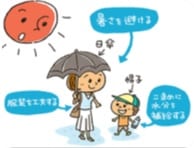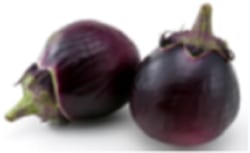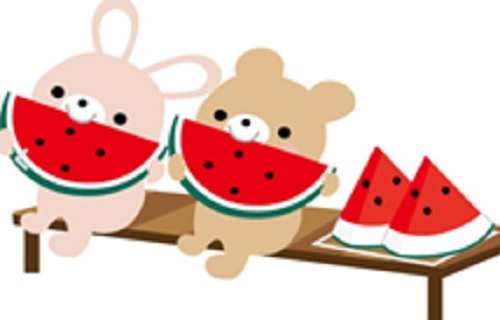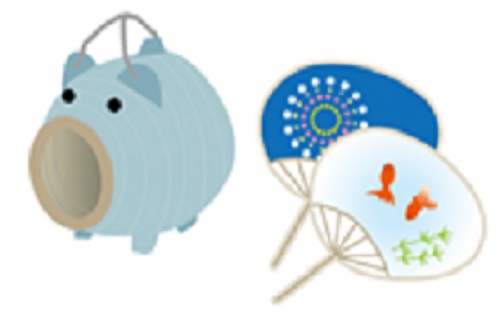INFORMATION
- Home
- INFORMATION
- Kyoto’s summer traditions
03.Aug.2020
DISCOVER JAPAN
Kyoto’s summer traditions
In this issue, I would like to introduce heatstroke prevention measures and Kyoto’s summer traditions.
Let’s prevent heatstroke
During the hot summer months, long periods of intense physical activity and high humidity can make you more susceptible to heatstroke.
It is dangerous to have a headache or to lose your consciousness. The human body made up of about 60% water. If this water reduces more than necessary, it will dehydrate and cause heatstroke. Dehydration has already begun when your throat is dry, so be careful to drink water before your throat becomes dry.

Points for preventing heatstroke
- Frequently rehydrate
- Use air conditioners and fans well
- Cool yourself with a shower or towel
- Measure the temperature in the room
- Do not overdo when it is hot
- Wear cool clothes. Carry parasols and wear hats when going out
- Make the room airy
- Check contact information in case of emergency or trouble
At school, we always give priority to wearing a mask, but we would like to respond flexibly while considering heatstroke. - Ensure sufficient physical distance
*If you have any concerns, please feel free to contact us at school.
Keep in mind that the following precautions can be helpful.
- Advoid intense exercise when it is hot.
- If you are feeling unwell (lack of sleep, not eating meal, tired, etc.), do not overdo it.
- Drink lots of water such as tea and sports drinks containing salt (It is said that recovery from heat exhaustion will be delayed if the body lacks salt.)
* With severe heatstroke, it can be fatal. To recover quickly from heatstroke, rest in a well-ventilated and cool place, sprinkle water on the body and cover it with a fan, or apply ice to the areas with thick blood vessels to remove heat from the body. If the reaction is strange, call an ambulance (No. 119).
Do you know Kyoyasai?
Kyoyasai are vegetables that have been cultivated in Kyoto since the ancient times.

Fushimi peppers
It is one of the Kyoyasai and has been made in Fushimi Ward in Kyoto City since ancient times. It has a long and slender shape and has no taste.

Manganji peppers
It was named Manganji peppers because it was found in the Manganji area in Maizuru City, Kyoto Prefecture. It has been planted for about 100 years.

Kamo eggplant
It is fluffy, round like a ball, and has a glossy black-purple color. Its flesh and skin are soft and have a sweet taste.
*Click here for a collection of Kyoto vegetable (Kyo Yasai) recipes.
The set meal of a family in Nakagyo Ward for offering in Bon festival.
| The 13th | For evening: Stewed red beans, French bean salad, Nara-style pickles |
| The 14th | For noon: Simmered freeze-dried tofu, Simmered shiitake mushrooms and taro, Eggplant salad, Miso soup, Pickles, Vegetables pickled in salted rice-bran paste |
| The 15th | Sweet and sour taro stem, Vegetables soup, Pickles For night: Soumen noodles, Soba noodles salad |
| The 16th | For breakfast: Steamed glutinous rice, Tofu soup, Simmered sea oak and deep-fried tofu, Pickles |
Kyoto Bon Festival(Bon)
Bon is correctly called ‘Uraboneand its origin is said to be derived from the Sanskrit word “ullambava” (inverse spelling: one of the sufferings in hell). People invite their ancestors to come to the house on August 13th. Along with the Gozan no Okuribi bonfire on the night of the 16th, they will send their ancestors off with a promise of seeing each other again in underworld. In Kyoto, where traditional customs remain, there are Bon festival events such as the Rokudou Mairi and Mantoue, and at night votive lanterns and lanterns are lighted up, creating a fantastic atmosphere.
- In Kyoto, ancestor spirits are called ‘The spirits’
- One of the traditional events that welcome spirits is ‘Rokudo Mairi’
- The Gozan no Okuribi bonfire will be held to send the spirits to the underworld again
*Details are posted on the homepage(Kyoto Tsu no Susume)



In Kyoto, every year on the evening of August 16, as a ‘Bonfire’ event, five mountains surrounding the city of Kyoto are ignited by fires in the shape of large letters and pictures, attracting many visitors. The Big letter (Daimonji) is well known, but in fact there are five of them includes “Myohou”, “Funagata”, “Big letter on the left(Hidaridaimonji)”, “Toriigata”, and they are ignited in order. It also means that summer vacation is about to end. Actually, We can see the shape of The Big letter (Daimonji) and pictures from the rooftop of Kyoto campus.
Come to the campus and check out what The Big letter (Daimonji) and pictures we can see from here!

Answer:We can see Daimonji, Hidari Daimonji, Funagata

